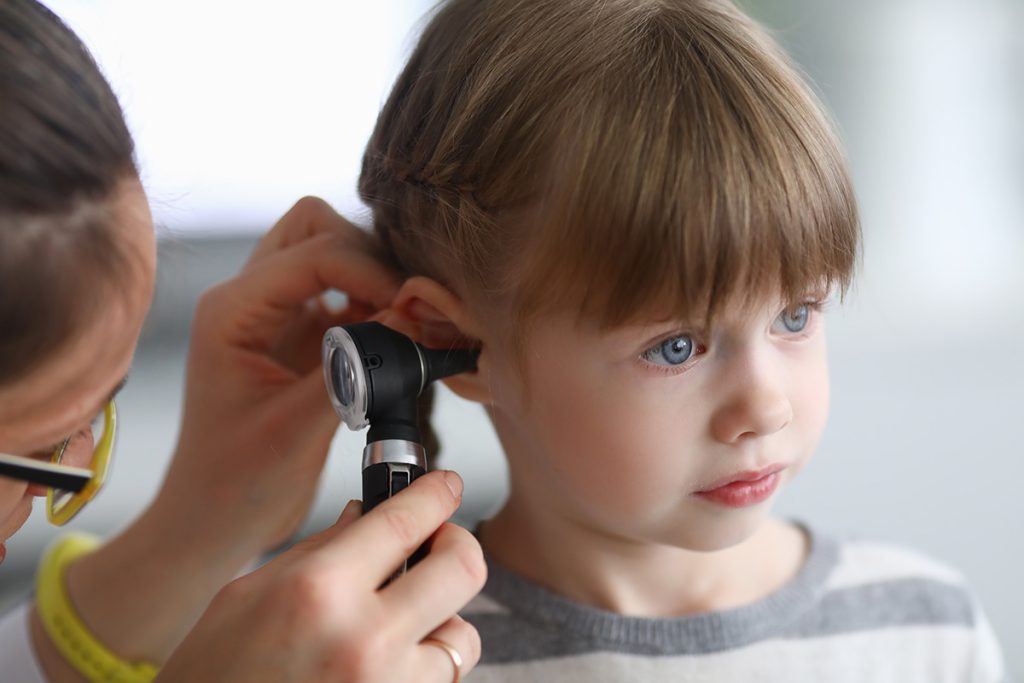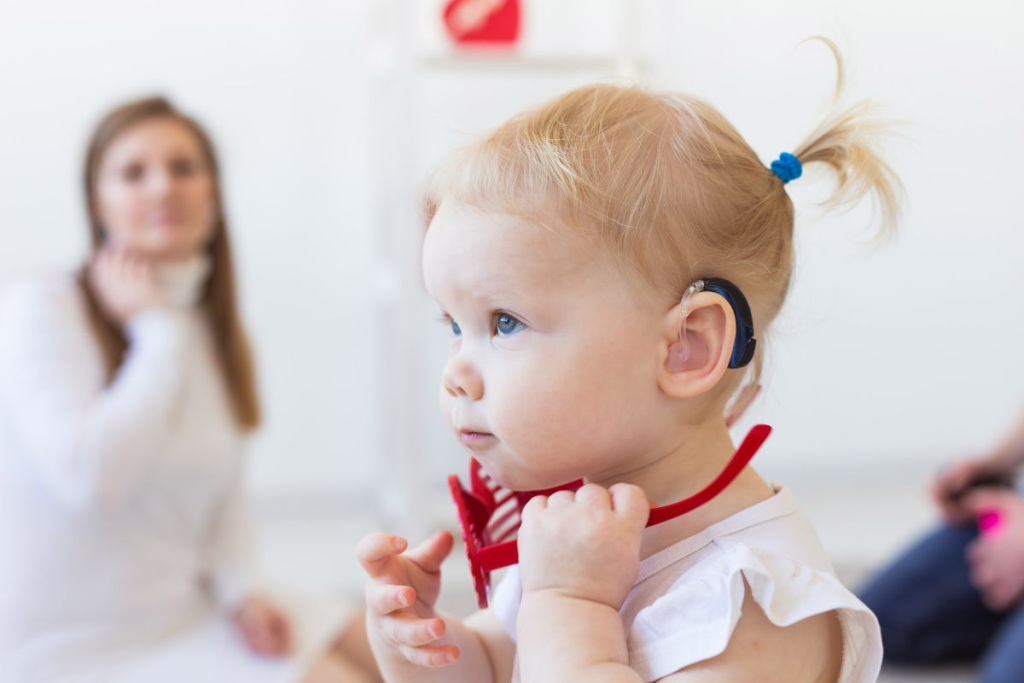Ear infections are a common reason children visit pediatricians, and antibiotics are often prescribed. Updated clinical guidelines now recommend a more targeted approach to ear infection treatment for more effective care.

Research shows that around 95% of children with ear infections receive antibiotics. But 75% of cases improve without this intervention. Pediatricians most commonly treat ear infections with antibiotics, but a more nuanced approach is emerging.
It’s important for parents to know about pediatric ear infections. These infections happen when bacteria or viruses cause fluid to build up behind the eardrum. Kids are more likely to get them because their ear tubes are shorter and more horizontal.

Several factors contribute to ear infections in kids. Their Eustachian tubes are shorter and more horizontal, making it easier for germs to get in. Exposure to secondhand smoke, daycare, and allergies also raises the risk. Knowing these causes helps in preventing and managing ear infections.
Ear infection symptoms change with age. Infants might be irritable, have a fever, or have trouble sleeping. Older kids might say their ears hurt or have trouble hearing. Spotting these signs early is key to treatment.
It’s important to know when to seek medical attention. If your child has severe ear pain, a fever over 102 °F, or symptoms get worse, see a doctor. Also, if there’s hearing loss or treatment doesn’t work, get medical help.
By understanding causes, recognizing symptoms, and knowing when to seek help, parents can manage their child’s ear infections better.
Dealing with ear infections in kids has become a big deal. The worry about antibiotics not working as well has led to new ways of treating them. Now, doctors are focusing on treatments that really work.
In 2013, the American Academy of Pediatrics changed how ear infections are treated. They said it’s key to know the type of infection and treat it right. This way, doctors can avoid giving antibiotics when they’re not needed.
Targeted treatment guidelines mean antibiotics are only used when they really help. This helps fight antibiotic resistance and cuts down on side effects from too many antibiotics.
Sometimes, doctors say to wait and see how things go. This is called watchful waiting. It’s okay for kids with mild symptoms or who can tell their doctor how they feel. About 75% of ear infections get better on their own.
But some kids need to see a doctor right away. This includes babies under two, kids with bad symptoms, or those with weak immune systems. If symptoms get worse or don’t get better in a few days, they need to see a doctor.
Using evidence-based treatment approaches helps kids get the best care for their ear infections. It makes them feel better and helps fight antibiotic resistance, too.
Antibiotic therapy is key in treating ear infections, mainly when bacteria are involved. It aims to kill the bacteria, prevent complications, and ease symptoms.
Amoxicillin is the top choice for treating ear infections. It works well against common bacteria like Streptococcus pneumoniae. Doctors often prescribe high doses to fight off resistant bacteria.
They usually give amoxicillin for seven to 10 days. This length has proven effective in treating most infections.
For those allergic to penicillin, other antibiotics are needed. Azithromycin and cefdinir are good options. The right choice depends on the allergy’s severity, medical history, and local resistance.
It’s important to check WebMD for the latest treatment advice.
The high rate of antibiotic prescriptions for ear infections is a big deal. Antibiotics are great for bacterial infections, but overusing them can lead to resistance. Doctors need to use antibiotics wisely.
They should only prescribe when necessary and choose the best antibiotic. This helps prevent resistance and ensures effective treatment.
In summary, antibiotics are essential in treating ear infections. Understanding amoxicillin and other antibiotics helps doctors make the best choices. This balance is key to treating infections without promoting resistance.
Pediatricians are always looking to improve how they treat ear infections in kids. They want to make sure the treatment works well, but also doesn’t use too many antibiotics. This is because too many antibiotics can lead to problems.

Studies have found that shorter antibiotic treatments work just as well for kids over two. These treatments last 5-7 days. Short-course therapy makes it easier for kids to stick to their treatment and helps prevent antibiotics from becoming less effective.
“Shorter antibiotic treatments are a big step forward in taking care of kids,” says the new guidelines. They match the treatment to what the patient needs.
Even though shorter treatments are becoming more common, longer ones are sometimes needed. This is true for more serious infections or for younger kids. The choice of treatment length depends on how sick the child is and other factors.
Research is ongoing to see how different treatment lengths affect recovery. Scientists are also looking into vaccines for ear infections. This could lead to even better treatments.
Pediatricians keep up with the latest research and guidelines. This helps them give the best care for kids with ear infections. They aim to treat effectively while fighting antibiotic resistance.
Ear infections can hurt a lot. It’s key to manage this pain for the child’s comfort. Good pain management makes the child feel better and less stressed.
Acetaminophen and ibuprofen are often used to ease ear infection pain. Knowing how much to give is important for safety and effectiveness.
Acetaminophen is given at 10-15 mg/kg every 4-6 hours. It should not be given more than 5 times in 24 hours. It comes in liquid form for kids. Ibuprofen is given at 5-10 mg/kg every 6-8 hours. It should not be given more than 3-4 times in 24 hours. It also comes in liquid form for kids.
Ear drops can also help with pain. Some drops have pain-relieving ingredients. For example, certain prescription ear drops can be used with a doctor’s advice.
There are also home care steps that help. A warm compress on the ear can ease pain. It’s also important for the child to rest and drink water. Keeping the head up can also help with ear pain.
Parents should talk to their doctor to find the best pain relief for their child. This includes the child’s age, how bad the infection is, and any past reactions to medicine.
New tools and better ways to use antibiotics are changing how we treat ear infections in kids. These changes help doctors make better diagnoses and use antibiotics wisely.
New diagnostic tools are making it easier to spot and treat ear infections. Tympanometry and acoustic reflectometry help doctors check the middle ear and find infections. This means doctors can choose the right treatment for each child.
Programs focused on using antibiotics wisely are helping to fight antibiotic resistance. These programs make sure kids get the right treatment and cut down on antibiotic use by up to 50%. Evidence-based guidelines are key to this success.
Using proven treatment plans is another big step forward in ear infection care. These plans make sure treatments are based on the latest research. This way, doctors can give kids the best care consistently.
In summary, combining new diagnostic tools, smart antibiotic use, and proven treatment plans is changing ear infection care. These steps not only improve treatment but also help keep antibiotics effective for the future. This means better care for kids.
The medical world is working hard to find the right way to treat ear infections in kids. It’s important to know when antibiotics are needed and how to ease symptoms.
It’s all about finding a balance. We need antibiotics to fight infections, but we also have to be careful not to make bacteria too strong. By using antibiotics wisely, doctors can help kids get better without overusing these medicines.
Doctors are key to making this balance work. They use the latest research to decide when to use antibiotics. This not only helps kids feel better but also helps fight antibiotic resistance.
Ear infection symptoms can vary by age. Common signs include ear pain, fever, and irritability. Infants might tug or pull at their ears.
Treatment often includes antibiotics, like amoxicillin. Pain relief, such as acetaminophen or ibuprofen, is also recommended.
Some ear infections may clear up on their own. But others need medical help. Mild cases might be watched, but severe ones need antibiotics.
Acetaminophen dosage for ear pain varies by age and weight. Always follow a pediatrician’s advice or the medication’s label.
Not all ear infections can be prevented. But breastfeeding, avoiding smoke, and keeping up with vaccinations can help lower the risk.
Ear infection duration varies. With antibiotics, symptoms often improve in a few days. It’s key to finish the treatment.
For those allergic to penicillin, azithromycin or cefdinir can be used instead.
Use pain relief medication and a warm compress. Ear drops, as directed by a pediatrician, can also help.
New diagnostic tools and antibiotic use are improving care. Evidence-based treatment protocols are being used to achieve better outcomes.
Ibuprofen can help with ear pain. But always follow the dosage guidelines and talk to a pediatrician first.
Watchful waiting means monitoring symptoms without antibiotics right away. It’s for mild cases or when the diagnosis is
Subscribe to our e-newsletter to stay informed about the latest innovations in the world of health and exclusive offers!
WhatsApp us